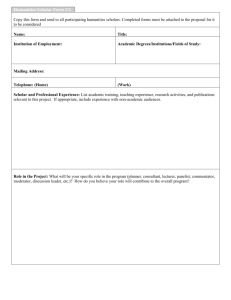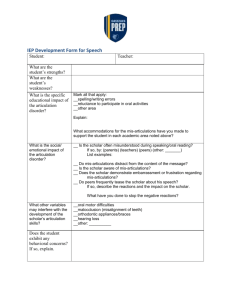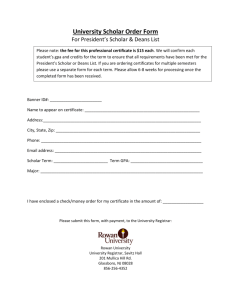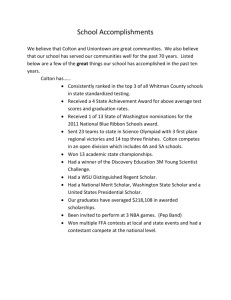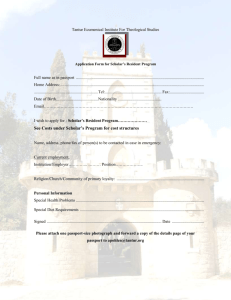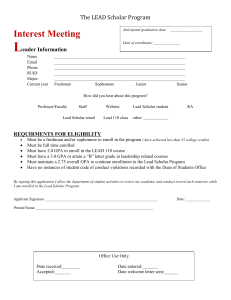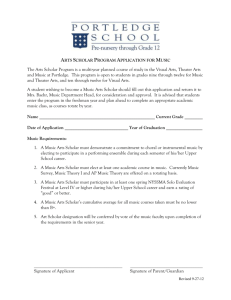Guidelines for Tutoring
advertisement
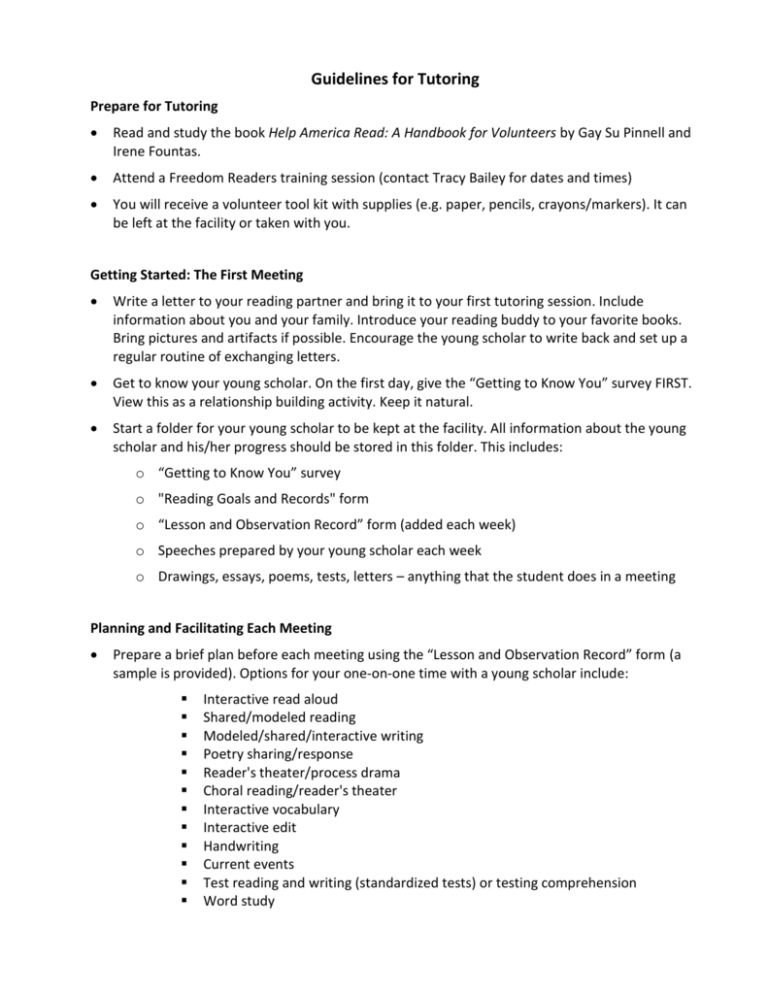
Guidelines for Tutoring Prepare for Tutoring Read and study the book Help America Read: A Handbook for Volunteers by Gay Su Pinnell and Irene Fountas. Attend a Freedom Readers training session (contact Tracy Bailey for dates and times) You will receive a volunteer tool kit with supplies (e.g. paper, pencils, crayons/markers). It can be left at the facility or taken with you. Getting Started: The First Meeting Write a letter to your reading partner and bring it to your first tutoring session. Include information about you and your family. Introduce your reading buddy to your favorite books. Bring pictures and artifacts if possible. Encourage the young scholar to write back and set up a regular routine of exchanging letters. Get to know your young scholar. On the first day, give the “Getting to Know You” survey FIRST. View this as a relationship building activity. Keep it natural. Start a folder for your young scholar to be kept at the facility. All information about the young scholar and his/her progress should be stored in this folder. This includes: o “Getting to Know You” survey o "Reading Goals and Records" form o “Lesson and Observation Record” form (added each week) o Speeches prepared by your young scholar each week o Drawings, essays, poems, tests, letters – anything that the student does in a meeting Planning and Facilitating Each Meeting Prepare a brief plan before each meeting using the “Lesson and Observation Record” form (a sample is provided). Options for your one-on-one time with a young scholar include: Interactive read aloud Shared/modeled reading Modeled/shared/interactive writing Poetry sharing/response Reader's theater/process drama Choral reading/reader's theater Interactive vocabulary Interactive edit Handwriting Current events Test reading and writing (standardized tests) or testing comprehension Word study Letter writing Guided reading (introduce text, read text, discuss and revisit, graphic organizer) Essay or poetry writing. Before each meeting, choose a book for your scholar and figure out how you can support the young scholar through it. Try to expose students to a variety of books….realistic fiction, historical fiction, fantasy and science fiction, fables, myths, biographies, informational books, etc. The last half of the session can be spent with the book of student choice. Help the student prepare for his/her one-minute speech which will be presented to the group at the end of the meeting. The topic will be announced each week. Wrapping-up Each Meeting Encourage students to read at home. Remind students to bring their favorite books with them to be re-read. We'll keep them in a "Beloved Books" box. Record the book(s) that your young scholar read on the Reading Goals and Records form help the scholar keep track of pages read using this form. Record your reflections on and observations of the meeting with your young scholar using the “Lesson and Observation Record” form. Store all forms and student work in the student folder. Return student folder and tutor tool kit to the storage location. Suggestions for Effective Tutoring Sessions Make a brief, written outline for your session Plan for a variety of activities Have materials organized and ready before you start with the child. Include both reading and writing. Make sure the child is actively engaged. Keep a lively pace (don’t get stuck on one activity). Make sure the child is always successful (not struggling). Record notes about how the session went and points you want to remember next time. Reorganize materials and make a brief outline for the next session. General Tips for Tutors Create a risk free environment for learners. Get to know students’ interests and backgrounds. Have conversations. Listen hard and be set for diversity. Value the students’ individual communities from which they come. Keep students interested and engaged. Provide opportunities for students to connect what they know with new information. Provide individual attention and tailored instruction for students. Work regularly with students in a one-on-one setting. Be persistent but flexible. Expect surprises. Be able to change direction when it is necessary. Read students’ signals (when they are comfortable, uncomfortable, enjoying activities, etc.). Help students experience success. Be positive and work from students’ strengths. Praise students and look for their approximations (focus on ‘the half right’). Surround students with quality texts. Provide opportunities for social interaction through such activities as shared reading, buddy reading, interactive writing, choral reading, songs, poetry, and rewritten books. Learn from other people. Resources for Testing Student Comprehension Alpha-Boxes. Have the student name one thing from the book (e.g. character names, places, items of importance, things that happened) that begins with each letter of the alphabet. Quizzes. Give a short quiz to the student about what they read. You may quiz them on the plot (what happened first, second, third), character names, places, major themes. This can be done orally or written. Venn-Diagram. Have the student use ven-diagrams (overlapping circles) to compare himself to the main character in the story. The traits that the student and the main character have in common should be listed in the overlap between the two circles. Written Summary. Ask the student to write a short summary of the book, including the plot and main characters. This will help develop writing skills also, especially for older scholars. Common Issues and Solutions Issue: Student skips words s/he does not know. Possible Solutions: Reading is about meaning-making. Encourage young scholars to use all of the information presented in the book including pictures, surrounding words, and the context of the story. If the scholar skips words, but still derives a meaning that makes sense, do not interrupt the flow of reading session to correct the child. . Issue: Student fills in words s/he doesn’t know with some similar sounding word. Possible Solutions: Don't interrupt the flow of reading. If the scholar can make sense of the text this way, fine. Focus on what the reader is doing well. Praise the “half-right”. Issue: Student gets frustrated when s/he does not know a word or you will not give the answers. Possible Solutions: The reading session should be enjoyable. Don't force a student to struggle with unfamiliar words for a long time. If he doesn't know a word, tell him what it is. Progress is the goal here. Issue: Student reads the words on the page, but does not understand what s/he has read. Possible Solutions: This is a comprehension issue. As a tutor, you might consider recommending books that are a bit less challenging. Once you get to know the scholar, his interests, and abilities, you should try to match the child with a "just right book". This is a text that isn't too challenging or too easy. Issue: Student would rather talk, draw, play, etc than read. Possible Solutions: This almost always means that the child does not yet find reading pleasurable. In this situation, it might be best to read to the student. Choose books with which you connect and can read with a great deal of excitement. Also, find out what the child is interested in and find books on that topic which would be fun and easy for the student, either to read or just look at. After the reading, try to tailor your conversations around the book. Encourage the young scholar to draw pictures that reflect their understanding of the text. Also, the two of you might try making up your own stories. The scholar could draw the pictures and you could provide the words. . More Advanced Strategies for Expanding Meaning Connecting--To relate one thing to another—the reader must connect using funds of knowledge from personal, world, and text experience Inferring--To make a decision or form an opinion by reasoning from known facts or evidence—the reader must go beyond the literacy meaning of a text to derive what is not there but is implied Summarizing--To present the general idea in brief form—the reader must put together important information while reading Synthesizing--To bring together parts or elements to form a whole—The reader must put together information from text, personal, world, and literary knowledge to transact with the text, or create new information Analyzing—To separate and break a whole into its parts to find out their nature, proportion, function, interrelationships, and properties—the reader must closely examine elements of a text to achieve greater understanding of how it is constructed Critiquing—To make judgments through analyzing the qualities and evaluating them—the reader must judge or evaluate a text based on personal, world, or text knowledge. Adapted from Fountas & Pinnell, 2001 pp. 312-318

